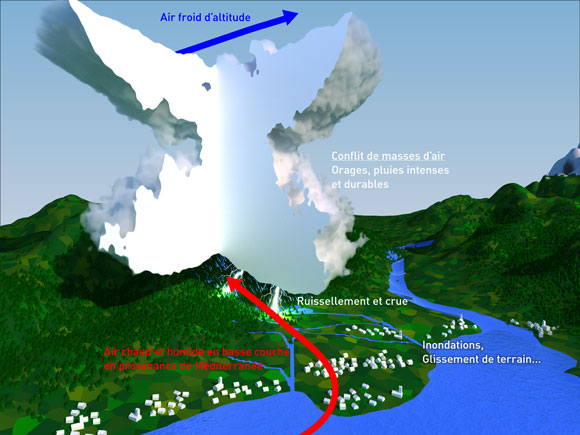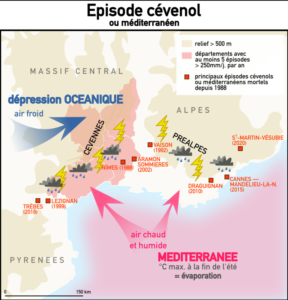What is a Cevenol épisode méditerranéen? In short it is a period of intense storms and incredibly heavy rains that causes extensive flooding, often in the form of flash floods, that hits the plains and the foothills of Southern France. The storms and rains can last a night or up to three days.
We moved to the Corbieres in November 1999. We previously had lived in Brussels, my job involved very frequent flying meaning I left the house early Monday morning and returned late Friday night. The MEP Caroline was working for decided to stand to be President of her country so Caroline’s job looked in jeopardy. I had a great boss who was unconcerned whether I got my Monday flight out of Zaventem, Toulouse-Blagnac or Barcelona. As Caroline said she would rather not see me in the South of France than not see me in Brussels. So we found a little house in Ribaute on the banks of the Orbieu . The house was situated on a small cliff that over looked the river, to our left was a beautiful stone bridge that the kids jump off in Summer. Beyond that is a waterfall and a dam to stock the water for the old mill.
We had only seen the house in Summer, in the few times we had visited I don’t think we had ever seen a cloud in the sky, let alone a drop of rain.
We drove down from Brussels in one day, we left Belgium in the rain, nothing new there. As we passed Lyon the rain got heavier, and heavier. The sky when from grey to black, to what I can only describe as purple. Passing Nimes the traffic on the Auroroute had slowed to 50 km an hour, visibility was terrible, by Lezignan Corbieres the speed had reduced to 30. I have never been so thankful to get off the motorway.
We finally made it to Ribaute, despite the road between Fabrezan and Camplong being closed. To find a dark house, the electricity line had been cut. The walls of the house were literally shaking. The river had been transformed from a gentle flow to a thundering torrent, the bridge had disappeared, entire trees were floating by. Luckily the village was well placed and the main force of the water was flowing over the opposite bank.
21 people in the Aude died that night, including the mayor of Lezignan’s mum, the majority of the dead drowned in their cars trying to make it to safety.
That was our first experience of an épisode méditerranéen, or a Cevenol. It was not to be our last. These supposedly once ever 50 year events have become more and more frequent.
So what causes a Cevenol or épisode méditerranéen?
Apparently it is an Autumn combination of a hot Summer heating the sea, a Marin, the south/south east sea wind and a depression in the Bay of Gascoigne coming down from the Arctic.
The depression causes cold temperatures at high altitude and the depression strengthens the wind bringing the humid air from the Mediterranean. As the humid air rises on the foothills of the Cevennes, Black Mountains, or Corbieres Massif it meets the cold air which causes it to rain, hard. The high sea temperatures continue to push huge amounts of moisture into the air which in turn is sucked inland and dropped on plains and foothills.
To merit the name Cevenol épisodes méditerranéen at least 200mm of rain lust fall in 24 hours. I mm is I litre of rain fall per square metre. One of the major issues with theof Cevenol épisodes méditerranéen is there timing, they are most frequent in Autumn after a long hot summer. The land is partched and sun baked. It”sability to absorb heavy rainfall is severely limited so the water runs off causing streams and rivers to burst their banks. The rivers struggle to off load thsi amount of wtar into the sea. They are also not aided by the fact that the Marin wind pushes the sea inland further slowing the rivers ability to expel the water, often leading to extensive flooding on the plains.
Now Cevenol épisodes méditerranéen are not new, the floods of the 17th August 1697 were seen as an act of God’s wrath. Now that the science has advanced we now know that Divine intervention has little to do with it. But the increased frequency of Cevenol épisodes méditerranéen in the past thirty years does lead scientists to believe that climate change, particularly the longer hotter summers has been a strong factor.
If you read French Meteo France has a comprehensive web resource here



